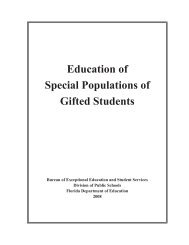Z2RbIu
Z2RbIu
Z2RbIu
Create successful ePaper yourself
Turn your PDF publications into a flip-book with our unique Google optimized e-Paper software.
Early Signs of Giftedness<br />
Linda Silverman, Ph.D.<br />
Another clear sign of giftedness is exceptional aptitude for mathematical reasoning. There are<br />
cases of five-year-old children solving square-root problems on calculators, inventing abstract<br />
algebraic formulations (e.g., (N x N) - 1 = (N +1) x (N-1)), learning algebra, adding four-digit<br />
numbers mentally, writing simple computer programs, or using calculations in their everyday lives.<br />
Since most preschool children are still learning how to count, these feats speak for themselves.<br />
An excellent sense of humor characterizes gifted children. They learn earlier than most other<br />
children that humor is based on incongruity, the unexpected or absurd. They also develop an early<br />
interest in and facility with puns. One two-year-old was playing under the bed where his mother<br />
was lying. He said to her, “Mommy, are you resting” When she replied, “Yes, “ he retorted,<br />
“Does that mean I'm under a rest” Incidents such as this one should be recorded. Making a<br />
booklet of a child's jokes is a way of encouraging language and cognitive development.<br />
Certain personality traits of the gifted child may appear early in life: perfectionism, emotional<br />
sensitivity, compassion, intensity. One-fourth of the sample I studied were described by their<br />
parents as “highly sensitive,” meaning both easily hurt and sensitive to the feelings of others.<br />
These two interpretations of sensitivity appear to be inter-related. Almost all of the children studied<br />
appeared to have signs of emotional overexcitability (Silverman, 1981).<br />
Personality characteristics differ markedly among the gifted (Robinson, 1977; Terman, 1925).<br />
Some characteristics make the child easy to identify as gifted, whereas others mask the child's<br />
special abilities. Since verbal precocity is such a frequent sign of giftedness, the highly verbal child<br />
is more likely to be recognized than the nonverbal child. Verbal ability is only one form of<br />
giftedness, however. Mathematically talented children, particularly boys, may not have high verbal<br />
ability (Stanley, 1981). Artistically, mechanically, spatially, or athletically able children also may<br />
not show verbal precocity; nevertheless, they are gifted.<br />
Shy children are likely to be overlooked as well. Gordon and Thomas (1967) studied gifted<br />
kindergarten children of different temperaments. Outgoing children who plunged into new<br />
activities easily and quickly were thought to be gifted by their teachers, although in fact many of<br />
them were average. All of the gifted children who were slow to get involved in new activities were<br />
incorrectly judged to be average in intelligence. Roedell, Jackson, and Robinson (1980) warn<br />
parents of the necessity of informing teachers that advanced intellectual skills are not always<br />
accompanied by outgoing temperaments.<br />
Although signs of high ability are usually present in the child's early years (Robinson, Roedell, &<br />
Jackson, 1979), many of the more subtle signs may go unnoticed. A child whose gifts go<br />
undetected will probably not receive the kinds of environmental stimulation necessary for early<br />
development. If this stimulation should occur later in life, the child is likely to be called a “late<br />
bloomer.” A late bloomer is a person with high potential who does not actualize that potential, or<br />
who is not discovered until later than would be expected.<br />
When opportunities for development are limited to only those children who show early signs of<br />
ability or productivity, much potential is missed. Gallagher (1979) reminds us that intelligence is<br />
not static; it is capable of both increasing and decreasing. It is important to provide continuous<br />
E-10; 4<br />
http://www.gifteddevelopment.com




